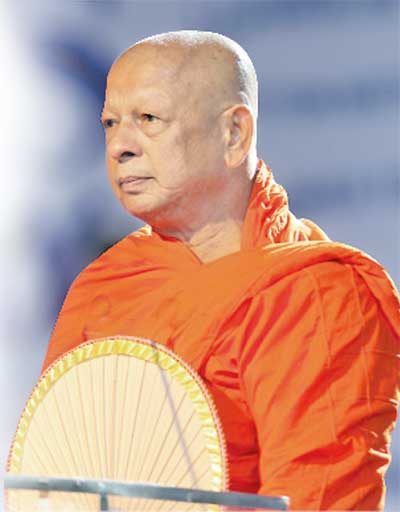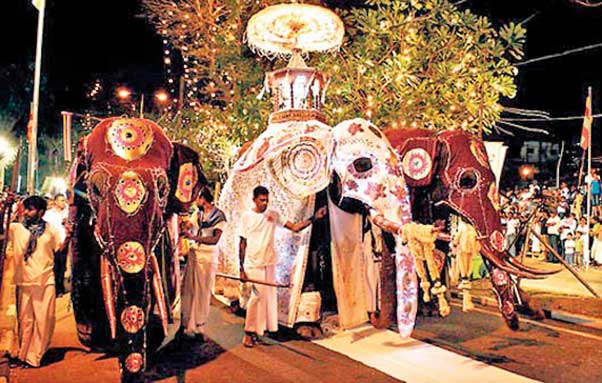_DM-10654.jpg) Directed by Chief Incumbent Venerable Galboda Gnanissara Thera
Directed by Chief Incumbent Venerable Galboda Gnanissara Thera
The Navam Perahera which is also known as Kolamba Perahera is conducted annually during the month of Navam at the Hunupitiya Gangaramaya Viharaya and perahera arrangements are made by the Gangaramaya temple. The entire organisation is handled by the young people associated with the temple under the capable direction of the Chief Incumbent Venerable Galboda Gnanissara Thera.
Originally the Kolamba Perahera was conducted in August immediately after the Sri Dalada Maligawa Esala Perahera in Kandy. The occasion for conducting Navam Perahera was to commemorate the first sermon of Gautama Buddha "Dhamma Cakka Pavattana Sutta" at Isipathanaramaya

Gangaramaya Raja Maha Viharaya
Gangaramaya was originally a small hermitage in a piece of marshy land at Hunupitiya within the municipal limits of Colombo. It was transformed into a nationally and

internationally famous Viharaya by Venerable Dewananda Sri Jinaratana Nayake Thera. Jinaratana Nayake Thera was liked and honoured by buddhists as well as by non- buddhists. With the cooperation of the people in the area the Thera transformed the little Avasaya into a large temple complex within a short period of time. Today Gangaramaya carries three main features, Sharairika Dhatu (physical remains of the Buddha), Maha Bodhi (the sacred Bo tree) and Buddha Rupa (Buddha Images). The main features of the temple includes the Viharaya (main temple) the Chetiya (dagoba), Bo tree, Vihara Mandiraya, Seemamalikaya and the relic chamber. In addition a museum, a library, a residential hall, a three-storied pirivena, an educational hall and an alms hall are also on the premises.
Origin of the Navam Perahera
In place of the former Kolamba Perahera an annual pageant is conducted during the month of Navam (February) beginning in 1979 with state patronage of then prime minister, R. Premadasa. The objectives of this pageant are varied. Primarily, it is to venerate the Triple Gem, The Buddha, His doctrine -the Dharma and Buddha's disciples the Sangha. Another objective is to commemorate the appointment of Arahants Sariputta and Moggalyana by the Enlightened One as his chief disciples (Agra Sravaka). The two most important positions in the Order of Maha Sangha were conferred on Arahant Sriputta (Dakunath Suw) and Arahant Moggalyana (Wamath Suw) by The Enlightened One at the first congregation on Navam full moon poya day after the Enlightenment.
Navam Perahera is also for the appropriation and sustenance of traditional dancing and other forms as well as Sinhala culture. It is also to encourage talented artistes and to keep their arts alive and be known. Thus the Gangaramaya Navam Perahera emerged during a time when no Buddhist pageant was conducted within the metropolitan area of Colombo. The Gangaramaya Perahera comprises a multitude of participants who in unison make the pageant magnificent.
Performers
Various kinds of performers make the pageant colourful. In addition to electric lamps in the streets and special illuminations of the festive days there are torch bearers who provide not only light but also colour to the pageant. Copra or dried kernel of coconut is put into torches and lit to illuminate the surroundings.

Whip Crackers
Whip crackers serve a number of purposes. Firstly it is a means of clearing the way for the main perahera. Secondly the cracking whips confine spectators to the pavement and leave the road entirely for the procession to pass without any disruption. Thirdly it is a signal that the main procession is approaching. It is also an offering made by sound indicating the majesty of the procession. It is said that even the celestial beings hear that sound which is an invitation to them to watch the procession. Devotees young and old including school children walk behind the whip crackers carrying flags and banners and trays of flowers.
Elephants
Beautifully adorned elephants including tuskers provide majesty and elegance to the procession. The tusker of the temple carries the relic casket on its back. As in the case of the Sri Dalada perahera in the hill capital, Kandy, Kelaniya Duruthu Perahera and the Bellanwila Raja Maha Viharaya Perahera. Elephants walk in the Gangaramaya Navam Perahera too. They are adorned in costumes consisting three parts-the body part, the forehead garland called "Neththi Malaya'' and the ear ornament called "Kan Joduwa". Large quantities of padding, rich cloth, velvet coral etc. are required to make these costumes. Obviously these ornaments add to the elegance of the elephants which in turn provide elegance to the procession.
Dancers and drummers
Drama performers of the Gangaramaya Navam perahera can be categorised into four groups. There are the ordinary dancing teams representing Kandyan dancers, low country dancers and Sabaragamuwa dancers. The world's oldest and most ubiquitous musical instrument, the drum is used in all these dancing performances. Various kinds of drums such as "Gatabera", "Mangul Bera", "Yak Bera", "Udakkki", "Pantheru" and "Rabana" are used in these dancing performances. In addition a pair of cymbals, - "Talampota", also known as "Taitalama" the Tamil cymbal is used with the tambourine to provide timing. Tambourines are beaten to produce rich and melodious sounds in harmony with the dancers and "Vannams" or songs of the performers. Talampota is used in all the dancing performances to keep the rhythm through the loud ringing sound made when the two cymbals are hit together.
Hewisi drummers
The most important group is the Hewisi drum players. They produce a drum roar with the large drum, "Daula", the double drum "Thammattama " and the trumpet or the bugle horn "Horanewa". Meanwhile conch shell blowers produce gentle and prolonged sounds increasing the serenity of the atmosphere. Dancers in their costumes look elegant when they move in the procession. They sing Vannams while dancing. Vannams are metrical verses sung by dancers to provide lyrical music in their

performances. There are eighteen Vannams such as Thuranga (horse) Vannama, Vairody (cat's eye gem) Vannama, Savula (cock) Vannama and the most important Gajaga (elephant) Vannama. When the performers dance to the tune of the Gajaga Vannama they move just like elephants.
Ves and Pantheru dancers and Borukakul karayas
A special kind of Kandyan dancing is known as "Ves Natuma". Dancers of this category have to undergo training for a long period of time before they are considered as fully fledged Ves dancers. The performer will be entitled to the Ves costume with a beautiful Head dress only after being well trained. Pantheru dancers form another group. Each dancer has a circular instrument called the "Pantheru" which produces a tinckling sound. This makes the performance melodious.
"Borukakul karayas" or slit walkers produce special colour to perahera. The performers walk high above the ground on two long pieces of wood with places to rest their feet on. They sneer at the spectators from above and provide them entertainment.
"Originally the Kolamba Perahera was conducted in August immediately after the Sri Dalada Maligawa Esala Perahera in Kandy. The occasion for conducting Navam Perahera was to commemorate the first sermon of Gautama Buddha "Dhamma Cakka Pavattana Sutta" at Isipathanaramaya"
A significant feature about this pageant is that it is planned and organised in an excellent manner. The perahera parades a number of streets and the main road in front of the Gangaramaya Viharaya and along the Beira Lake - Navam Mawatha. Seating accommodation is provided for spectators. The perahera route is determined and the places where elephants, dancers, drummers and torch bearers, the Maha Sangha, office bearers and others who participate in the pageant are well directed. Nothing is left for the pageant to get disorganised.
_DM-10654.jpg) Directed by Chief Incumbent Venerable Galboda Gnanissara Thera
Directed by Chief Incumbent Venerable Galboda Gnanissara Thera
 internationally famous Viharaya by Venerable Dewananda Sri Jinaratana Nayake Thera. Jinaratana Nayake Thera was liked and honoured by buddhists as well as by non- buddhists. With the cooperation of the people in the area the Thera transformed the little Avasaya into a large temple complex within a short period of time. Today Gangaramaya carries three main features, Sharairika Dhatu (physical remains of the Buddha), Maha Bodhi (the sacred Bo tree) and Buddha Rupa (Buddha Images). The main features of the temple includes the Viharaya (main temple) the Chetiya (dagoba), Bo tree, Vihara Mandiraya, Seemamalikaya and the relic chamber. In addition a museum, a library, a residential hall, a three-storied pirivena, an educational hall and an alms hall are also on the premises.
internationally famous Viharaya by Venerable Dewananda Sri Jinaratana Nayake Thera. Jinaratana Nayake Thera was liked and honoured by buddhists as well as by non- buddhists. With the cooperation of the people in the area the Thera transformed the little Avasaya into a large temple complex within a short period of time. Today Gangaramaya carries three main features, Sharairika Dhatu (physical remains of the Buddha), Maha Bodhi (the sacred Bo tree) and Buddha Rupa (Buddha Images). The main features of the temple includes the Viharaya (main temple) the Chetiya (dagoba), Bo tree, Vihara Mandiraya, Seemamalikaya and the relic chamber. In addition a museum, a library, a residential hall, a three-storied pirivena, an educational hall and an alms hall are also on the premises.
 performances. There are eighteen Vannams such as Thuranga (horse) Vannama, Vairody (cat's eye gem) Vannama, Savula (cock) Vannama and the most important Gajaga (elephant) Vannama. When the performers dance to the tune of the Gajaga Vannama they move just like elephants.
performances. There are eighteen Vannams such as Thuranga (horse) Vannama, Vairody (cat's eye gem) Vannama, Savula (cock) Vannama and the most important Gajaga (elephant) Vannama. When the performers dance to the tune of the Gajaga Vannama they move just like elephants.